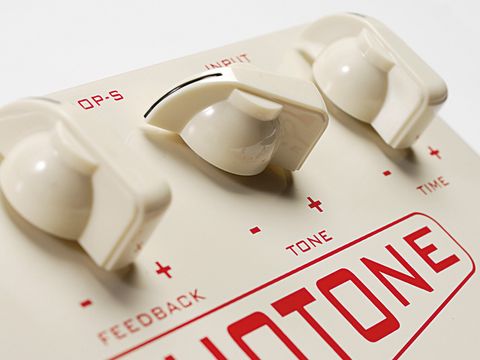Carl Martin makes some of the best-sounding effects you can buy; they are always designed with the gigging musician in mind. The pedals are always seriously roadworthy, and the higher line units have trailing mains leads, not wall warts, and a bombproof metal case.
The new EchoTone is no different, although it's the only Carl Martin unit that comes in this rather natty and retro cream colour with red legends.
Designed by Thomas Guldman, the colour scheme isn't the only difference to the new EchoTone. Compared to its nearest Carl Martin sibling, the DeLayla XL, it's similarly laid out, but the EchoTone differs by offering the user two different time-echoes.
While the Echo (wet/dry mix), Feedback (number of repeats) and Tone rotary controls affect both echo modes, the Time control is dedicated to the manually set delay time (20-1, 200msec) of the Echo footswitch.
The second delay time is set via the Tempo mode, and can only be tapped in by your foot. So, you could set up a slap-back echo manually then switch to a timed delay, tapped in via your foot, once your drummer gets up to speed.
"The pitch alters and self oscillates taking you far from the mainstream. Just add Bigsby and a wail of sustaining feedback…"
In addition, the EchoTone has some other tricks up its sleeve. Firstly, there's a loop that allows you to add some modulation to the delay repeats - chorus, flange, phase or overdrive for example, whatever takes your fancy. The loop is only active when the delay is engaged.
Secondly, there's a small mini-toggle on the back of the unit which allows the delay trails to decay naturally when you switch out the unit or stop dead. There's no legend on this switch so you'll have to experiment to hear the result. We could tell you but, hey, we don't want to ruin the fun!
Sounds
And fun you'll have. We call it the smile factor. You set up the pedal, kick in the delay and suddenly you find yourself grinning like a Cheshire cat. There's a dark purity to the pedal's overall tone and although the Tone control can darken (soften) or lighten (add click to) the trails, it's just such a beautifully organic, timeless (if you'll pardon the pun) sound, that you can't help but smile.
Here are three clips that illustrate the range of delay sounds on offer:
The shorter slap-back delays sound very old school and are easy to set up; very Memphis and old rock 'n' roll. Conversely, the longer delays give gained solo tones with a more modern gain level a wonderfully rich halo.
Things can get much more left-field by increasing the Feedback and by kneeling down and tweaking the Time control. The pitch alters and self oscillates taking you far from the mainstream. Just add Bigsby and a wail of sustaining feedback…
Our only gripe is that the tap tempo comes back, as expected, as a mirror of the beats you kick in. There's no additional mode switch to input dotted timings for Edge-like rhythms, unless you're very nimble with your foot.
This is a great product is one that takes you somewhere new and engages and encourages your creativity. If you just need a little bit of delay for a couple of solos you don't need the EchoTone, but if you're a delay junkie, we suggest you score one immediately.


